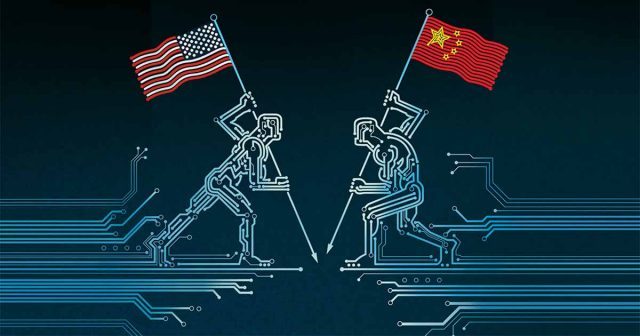The following article is written by Vincent Kolo of ChinaWorker.info, the website of the Chinese section of the Committee for a Workers International, with which Socialist Party in the Ireland is affiliated to.
The escalating U.S.-China conflict is nothing short of a major crisis for global capitalism. With negotiations having all but collapsed there seems to be no “exit ramp” from the trade war that began in July 2018. This crisis points to a prolonged and increasingly rancorous struggle with potentially serious global effects economically, politically, and even militarily.
The month of May saw a dramatic escalation with President Trump initiating a new round of tariff increases on Chinese goods and then broadening the conflict into a tech war, the costs of which could dwarf those flowing from his trade measures. Xi Jinping’s regime responded with retaliatory tariffs against the U.S., but its reaction has been cautious and measured, showing that for the time being it still hopes to avoid further escalation.
The executive order signed by Trump that bans U.S. companies from supplying Chinese telecom giant Huawei Technologies is nothing less than a state-led campaign by the U.S. to drive the company out of business and prevent Huawei, which has close links to the Chinese state, from achieving global dominance over 5G (fifth generation) wireless technology, the roll out of which is imminent. Trump’s decision puts Huawei on what is informally called a “kill list.” Currently Huawei, the global leader in 5G networks, sources half its microchips from U.S. companies.
This opens a new and potentially much more serious front in the superpower conflict. If the planned meeting between presidents Trump and Xi goes ahead on the sidelines of the G20 summit in Japan in late June it could still possibly produce some form of truce or cosmetic trade agreement. But with the gap between the two sides widening such an outcome looks increasingly unlikely.
These events confirm our assessment that the start of this conflict last year marked a key turning point in world relations. It is the beginning of a new era of sharpening imperialist conflict between the U.S. and China, which are “contesting every domain” as the Economist recently put it. In a different historical epoch these processes would probably lead to war, but in the age of nuclear weapons and mutual assured annihilation, with governments’ and the ruling classes’ lack of stable support and fear of mass unrest, thankfully this scenario is not posed.
It is vital, however, that the workers’ movement in both countries and globally develops an independent political position towards the Trump administration’s measures based on working class internationalism, opposing in equal measure the protectionism of nationalist politicians like Trump and Xi Jinping, but also the capitalist alternative of neo-liberal globalization. Under capitalism, both trade wars and trade deals are pursued in the interests of big companies and the financial elite, based on a never-ending race to the bottom in terms of workers’ livelihoods, democratic rights and the environment.
The escalation of the conflict has unsurprisingly sent shockwaves through global financial markets, which had “priced in” a U.S.-China trade deal. This false optimism was based mainly on the propaganda of Trump officials and the president himself. Like global capitalism as a whole, the Chinese “Communist” Party (CCP) dictatorship has once again been thrown off balance by Trump’s abrupt shifts. With the latest increases, almost half of China’s imports to the U.S. (worth $250 billion) are covered by 25% tariffs. In addition, Trump is threatening to extend the tariffs to all Chinese goods unless a deal acceptable to his government is reached.
New Cold War?
Rather than a one-off dispute, we have entered the first phase of an “economic cold war” encompassing not just trade and investments, but also science and technology, visas, academic exchanges, geopolitics, and accelerating military competition. This will especially be the case in the “Indo-Pacific” region as it has been renamed by the U.S. government, which now accounts for 28% of global arms spending, up from 9% two decades ago.
To be clear this is not just Trump’s policy. The Democratic Party, while remaining relatively quiet on this issue at the moment, also favors a “get tough” policy on China. In fact, historically they are the more protectionist party while the Republican Party espoused a hard line “free trade” doctrine which Trump has unceremoniously thrown out.
Unlike the standoff between U.S. imperialism and Russia’s Stalinist state-owned economy in the last century, this is not a conflict between incompatible socio-economic systems. It is rather primarily about deciding which ruling class will dominate and dictate the rules for the global economy in the future. There is a corollary in which China’s state capitalist economic model is pitted against America’s “free market” variant, but this is not the root of the conflict, despite the attempts of capitalist politicians in the U.S. to portray this as a struggle over “values”, as if suddenly discovering that China has an authoritarian system. The root of the conflict is a clash of imperial powers on a quest for global hegemony.
In fact, the current struggle suggests that state capitalist policies, with governments intervening to steer economic developments and “control” the market, could become more common globally, coexisting with more deregulation and privatizations. What after all are Trump’s latest $16 billion worth of farm subsidies (to compensate for China’s tariff retaliation) and the multitude of “national security” measures being introduced to block investments and exports especially in the tech sector. This shift to more intrusive state regulation of trade, financial flows, mergers and acquisitions, and academic exchanges, along with increasingly anti-democratic measures, is deeply ironic. “Rather than China becoming more Western, America is becoming more Chinese”, the Economist recently noted. A shift to selective use of state capitalist measures doesn’t mean the capitalists will abandon vicious neoliberalism, they’ll use both depending on the needs of the situation, much as the Chinese regime does.
The U.S., supported on this issue by Germany, France, and most European Union governments, is also pushing back vociferously against Xi Jinping’s signature Belt-and-Road Initiative (BRI) global infrastructure programme, attempting to profit from growing resistance in countries with BRI contracts to China’s “debt trap diplomacy”. The 70-nation BRI is an example of imperialism “with Chinese characteristics,” launched by Xi’s regime as a way to soak up China’s chronic industrial overcapacity and provide new profitable outlets for its banking system when much of the Chinese economy is gorged on debt.
The U.S. is also stepping up its military presence in the Western Pacific and the contested South China Sea to counter Beijing’s rapid naval build-up and its construction of militarized man-made islands. The escalation of maritime disputes involving China and several of its neighbors is partly about energy and fishing resources, but is mostly a “land grab” to enable China’s PLAN (People’s Liberation Army Navy) to control these waters and deny the U.S., with its slightly smaller but much more powerful navy, the ability to impose its writ across the region. Between 2014-18, China expanded its naval fleet by more than the French, German, Indian, South Korean, Spanish, and Taiwanese navies combined.
Both the U.S. and Chinese governments are engaged in intensifying diplomatic manoeuvers over Taiwan, which could become a dangerous flashpoint in the next period, especially as the island’s political system becomes more unstable and polarized. For the CCP dictatorship Taiwan is a core element in its nationalistic crusade to build a strong and “reunited” China, while for U.S. imperialism it is used to legitimise a continuing police role in Asia as well as being a lever to exert pressure on Beijing.
The End of “Engagement”
The new stage of U.S.-China rivalry ends more than 40 years of relatively stable and consistent “engagement,” which began with the Nixon administration in the 1970s and went on to become hugely profitable for U.S. capitalism. “We have truly crossed the Rubicon,” comments Chris Krueger of the Cowen Washington Research Group. “The Kissinger consensus is dead and China is a strategic rival. Full stop.”
This refers to Nixon’s secretary of state Henry Kissinger, whose secret visit to China in 1971 forged a new era of closer ties. At the same time, a full-blown ‘cold war’, if this develops, would pose unprecedented problems for capitalism in an era of generalized crisis, economic and political instability. “Today’s tensions make the original cold war look simple,” says the Economist’s “Special Report on China and America” (May 18, 2019). This is because China is the world’s biggest manufacturer, biggest exporter, second biggest importer, and a major force in global finance. By contrast, the Soviet Union, while a military superpower, had only a small presence in world markets, with two-thirds of its foreign trade conducted within the Stalinist bloc.
Economic Losses
The U.S. ruling class has become increasingly alarmed by China’s growing economic and geopolitical challenge to America’s number one spot, with Trump telling Fox News this is “not going to happen” on his watch. But the maintenance of U.S. global dominance will require policies that instead of spurring economic growth throw up barriers, bring chaos to complex global supply chains and reduce growth.
The OECD predicts that the intensification of the U.S.-China trade war will slice as much as 0.7 percent from global GDP by 2021-22. The impact on the U.S. and China would be bigger, by about 0.9 percent and 1.1 percent lower, respectively. Chinese officials have given similar estimates. Potentially the effects of the U.S.-China standoff could trigger a global recession and even unleash a new financial crisis.
Trump has insisted against all logic that China pays for his tariffs, when in fact it is U.S. companies that import from China and, increasingly, U.S. consumers that will foot the bill. The Federal Reserve Bank of New York calculates that the trade war will cost every U.S. household $831 a year. Especially with the conflict morphing into a tech war with the attack on Huawei, tens of thousands and even millions of jobs in the U.S. and China could potentially be at stake.
A shut down of Huawei would result in job losses for its workforce of 180,000 (including around 1,200 U.S. workers) and therefore is something Beijing would clearly never allow. But China’s tech sector is already facing a “winter” with a rise in layoffs and tighter competition for jobs, an average of 32 applicants per vacancy. This year has seen a growing revolt against the industry’s “996” culture (working nine to nine, six days per week), with Huawei being one of the worst offenders. The Chinese “996” protests online have received solidarity messages and support from U.S. tech workers for example at Microsoft, which shows the way forward to international action to defend jobs and conditions. The Chinese regime’s unemployment figures are unreliable and only cover the “urban” workforce, which excludes 280 million migrant workers in precarious temporary jobs in construction, manufacturing and services. But even the official unemployment data shows a rise to 5.2% in March, compared to just under 4% in April 2017. It is clear unemployment has now become a major concern for the government as its conflict with Trump deepens.
The Trump era means that average U.S. tariffs are not far below the levels under the 1930 Smoot-Hawley Tariff Act, according to the Peterson Institute for International Economics. Trump of course has also imposed global tariffs on steel and aluminum and has threatened wider tariffs on the EU as well as Mexico. While the ruling class supports Trump’s stand against China’s rise, there are serious misgivings about using tariffs as a key weapon of foreign policy and about the increase in protectionism generally. Recently, Walmart, Target and more than 600 other companies sent Trump a letter urging him “to resolve the trade dispute with China, saying tariffs hurt American businesses and consumers” (Reuters, 6/13/19).
There is a growing realisation that, rather than a temporary bargaining chip, today’s high tariffs could become a permanent reality. This is not least because the U.S. demands inserted into the 150-page draft agreement parlayed between China and the U.S. amounted to “economic regime change” in China. This is of course unacceptable to the Chinese dictatorship, especially a ruler so dependent on nationalist rhetoric as Xi Jinping.
As Stephen Bannon, the former Trump advisor and white nationalist guru, spelt out, “if the CCP agrees to the United States’ demands in an enforceable manner, it would amount to a legal and regulatory dismantling of Chinese state capitalism.”
State Capitalism with Chinese Characteristics
Emerging from the process of capitalist restoration that began in the late 1970s, the current Chinese regime and state has evolved unique features that mark it apart from other ex-Stalinist (or Maoist) states. Already at the time of the barbaric Beijing massacre thirty years ago, the regime of Deng Xiaoping and his successors decisively rejected the idea of experimenting with bourgeois democracy, which they feared would bring political “chaos” as well as the collapse of top CCP officials’ secret business activities, which have grown into vast but still secretive empires today.
Instead of acquiescing to a Western-led process of economic liberalization as occurred in much of Eastern Europe, China’s former bureaucratic elite maintained a totalitarian political system to hold the country’s centrifugal forces in check and insure that the growth of capitalism was politically shackled to serve the survival of the regime.
In this way, the dominant group within the Chinese capitalist class became the “princeling” families with direct connections to the top CCP hierarchy. Xi Jinping, whose family has overseas assets worth $1 trillion according to a recently leaked report in the Hong Kong media, represents the rule of the princelings over the state (it’s noticeable that no princelings have been targeted in Xi’s anti-corruption campaign which has brought down a record one million CCP officials in the past six years).
To maintain its rule, this peculiar capitalist regime eschews even limited “democratic” concessions such as a relaxation of press censorship or allowing more leeway in the NGO sector. Similarly, it jealously protects strategic economic spheres, using its control of a number of key state companies, because the profits and spectacular wealth of the princeling families and “red” capitalists is based on controlling these sectors.Xi and his trade negotiators have been prepared to offer concessions to Trump in order to de-escalate the trade war, and also because they see a symmetry of interests with the U.S. capitalists in allowing accelerated liberal reforms in some economic sectors. However, the issue of the regime’s overall control through state capitalist interventions has always been non-negotiable.
In the absence of a deal that would in reality require the CCP dictatorship’s capitulation, the aim of the Trump government seems to be to bring about a decoupling of the U.S. and Chinese economies, leading to what former Treasury Secretary Hank Paulson warned would be an “Economic Iron Curtain” between U.S.-led and Chinese-led spheres.
Decoupling
While there are certain obvious limits to how far an economic decoupling of the two economies can go, given the high degree of interdependence and the complexity of global manufacturing supply chains, what is clear is that a growing section of the U.S. capitalist class now favor this line, believing that if they don’t curb China’s economic and technological rise now it could soon be too late. They have swung behind Trump’s aggressive trade tactics in the hope this will either force the Chinese regime to open up its state-protected market to U.S. capital or force U.S. companies and Western allies alike to cut their ties with China’s economy.
But as the Brookings Institution, a U.S. think tank, noted in a recent report on the U.S.-China conflict: “The problem with this approach is that our allies and partners are not going to follow us down this road. For almost all of them, China is a bigger trading partner than the United States is, and a faster growing one. There would be huge economic costs to decoupling, and it would lead to an unstable world of competing economic institutions and blocs.”
The U.S. government’s campaign against Huawei, pressuring other governments to boycott the Chinese company’s 5G technology is an example of this. Australia, Japan, and New Zealand have lined up with the U.S. to exclude Huawei, as have some Eastern European governments, but Germany, France, and even Britain look likely to break ranks with the U.S. on this issue. This is mainly because of the huge costs and delays involved if Huawei is excluded from 5G rollouts.
The closure and relocation of many low tech and low value-added industries in China, as higher wages, land and pollution costs drive companies to Southeast Asia and beyond, is yet another imperative forcing the CCP regime to promote a technological upgrade towards high-end manufacturing, as outlined in its Made in China 2025 (MIC2025) plan. Yet this is a path that increasingly sets it on a collision course not only with U.S. capitalism, but also with the EU, Japan, and other industrialized powers who fear becoming economic and technical laggards as their own capitalists refuse to invest on the scale needed to keep pace.
At the same time these governments can be forced to turn to state capitalist solutions to bridge the investment gap in crucial technologies. Business lobby groups including tech giants Intel and Qualcomm have called on Trump’s administration to provide billions of dollars for research to stay ahead of China. And as Axios reported in 2018, top national security officials called on the Trump government to consider nationalizing the nation’s mobile network in order to build a centralized nationwide 5G network that would exclude Chinese technology.
Tech War and “Splinternet”
If it follows through, the Trump administration’s offensive against Huawei, by blocking its access to components and software including Google’s Android operating system, would effectively cut off its “oxygen supply” as one commentator noted. Predictably, this has drawn the sternest responses so far from Beijing, which has threatened to retaliate by choking off the supply of rare earth minerals to the U.S.. These minerals are crucial in a whole range of new technologies including advanced weaponry. China accounts for 95% of global rare earth output. Beijing has also threatened to create its own list of “unreliable companies” that could face retaliation by China if they refuse to do business with Huawei or other Chinese companies on “unfair” grounds.
The Huawei ban represents the most significant dent so far in the process of capitalist globalization, which has suffered a partial reversal since the global crisis of 2008. While a deal, a possible relaxation of the ban, could also be struck as Trump has hinted, this would most likely only mark a temporary suspension of hostilities, with further escalation at a later stage.
Huawei is not an isolated case but merely the tip of a very big iceberg in terms of the number of “national security” measures being prepared by various departments and agencies of the U.S. government to block Chinese investments and acquisitions in the U.S. and shut Chinese companies out of the U.S. tech sector. Already, Hikvision and Dahua, Chinese companies making surveillance systems and facial recognition technology, have been named as the next possible targets. The terms of Trump’s Huawei ban do not just apply to U.S. companies but also foreign companies, if they source at least 25% of their components from the U.S.
This raises the possibility of a technological divorce between the two economies and a digital divide or “splinternet,” involving mutually exclusive systems and technological standards. A key focus for this struggle is the battle over 5G.
If fully realised, 5G theoreticqally should accelerate the development of a vast range of revolutionary new technologies, from driverless cars to artificial intelligence (AI) and the “Internet of Things (IoT). However this will demand trillions of dollars in investments worldwide.
The tech war flows not least from the military implications of 5G, with the U.S. ruling class and the Pentagon fearful this will enable China to rapidly close the still wide gap that separates the two militaries. But it is also rooted in commercial considerations. Huawei, as the global leader in 5G technology (the company owns one-third of all 5G patents), is potentially positioned to dominate global communications systems. “Huawei could set the tech landscape for the next 10-15 years if it got that foothold,” argues China expert Christopher Balding.
“The Huawei case clearly shows that global economic networks have entered the realm of geo-strategy,” said Georgetown University professor Abraham Newman. “The hyper-globalisation of the last twenty years is unsustainable given the real geopolitical constraints. We are entering a new phase,” he told Hong Kong’s South China Morning Post.
For the workers’ movement internationally this technology and its implications for jobs and living standards are monumental. Likewise the issue of cyber security and the merits or dangers of Chinese versus Western technology raises crucial questions about privacy and the rights of the individual, but also about democracy and the threat from uncontrolled security agencies with mass surveillance programs. There is a complete lack of democratic controls and accountability not only in authoritarian China but also in the “democratic” West. These issues and others at the core of the current U.S.-China conflict raise the need for public ownership of major companies, democratic planning of the tech sector, infrastructure investments, and democratic control by workers and the general public over all aspects of the economy.
Conclusion
Trade conflicts, which are becoming the “new normal” for capitalism, can enormously exacerbate already strained relations between the different imperialist powers and regional configurations. This is the case not only with the U.S. and China, but to differing degrees also between the U.S. and the EU with Germany at its helm, Japan, Russia, and India. All of these powers have their own grievances and brewing conflicts with the U.S. under Trump, while also hoping to exploit Trump’s anti-China policies to secure advantages for themselves.
While the perspectives for the U.S.-China conflict are shrouded in uncertainty, and a trade deal or rather an “armistice” is not excluded, the current situation is full of dangers for capitalism worldwide and for both the U.S. and Chinese governments. Rather than the “easy win” that Trump boasted about one year ago, the conflict could exhaust and weaken both regimes with a similar effect globally. Economic stagnation, greater instability, and the risk of revolutionary upheavals are all processes that could be accelerated by this conflict.
For socialists the task is to prepare seriously, to follow events closely, and to campaign energetically around a program to build international working class solidarity and a socialist alternative to capitalist mayhem.












